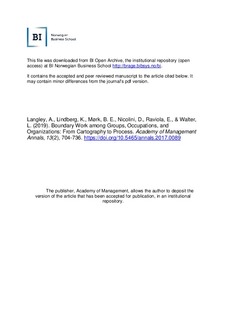Boundary Work among Groups, Occupations, and Organizations: From Cartography to Process
Journal article, Peer reviewed
Submitted version
Permanent lenke
http://hdl.handle.net/11250/2628343Utgivelsesdato
2019Metadata
Vis full innførselSamlinger
- Publikasjoner fra CRIStin - BI [1015]
- Scientific articles [2181]
Sammendrag
This article reviews scholarship dealing with the notion of “boundary work,” defined as purposeful individual and collective effort to influence the social, symbolic, material, or temporal boundaries, demarcations; and distinctions affecting groups, occupations, and organizations. We identify and explore the implications of three conceptually distinct but interrelated forms of boundary work emerging from the literature. Competitive boundary work involves mobilizing boundaries to establish some kind of advantage over others. In contrast, collaborative boundary work is concerned with aligning boundaries to enable collaboration. Finally, configurational boundary work involves manipulating patterns of differentiation and integration among groups to ensure that certain activities are brought together, whereas others are kept apart, orienting the domains of competition and collaboration. We argue that the notion of boundary work can contribute to the development of a uniquely processual view of organizational design as open-ended, and continually becoming, an orientation with significant future potential for understanding novel forms of organizing, and for integrating agency, power dynamics, materiality, and temporality into the study of organizing.
